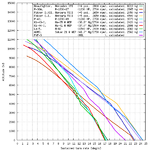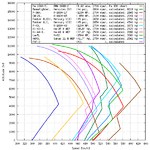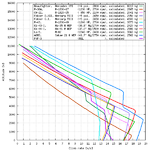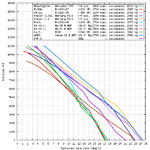Navigation
Install the app
How to install the app on iOS
Follow along with the video below to see how to install our site as a web app on your home screen.
Note: This feature may not be available in some browsers.
More options
You are using an out of date browser. It may not display this or other websites correctly.
You should upgrade or use an alternative browser.
You should upgrade or use an alternative browser.
Best radial fighter of '42
- Thread starter Vincenzo
- Start date
Ad: This forum contains affiliate links to products on Amazon and eBay. More information in Terms and rules
More options
Who Replied?- Thread starter
- #82
Hi HoHun
for CW-21 Curtiss-Wright CW-21 Demon Interceptor and can give a look on wiki
for CW-21 Curtiss-Wright CW-21 Demon Interceptor and can give a look on wiki
- Thread starter
- #83
Tentative of weaponry valutation
don't take in count the ammo reserve.
Type 96 Navy 1
Type 97 Army 1
Type 1 Army 2
G. 50 3,5
M.C. 200 3,5
Re 2000 3,5
D XXI 2,5
Hawk 75 NEI 2
Hawk 75 SF 2 or 2,5 or 3 (various combinations)
Hawk 75 RAF 2,5 or 3,5 (4 or 6 mg)
Type 2 Army 5
CW-21 5,5
P-35A 5,5
I 16 4
IAR80A 5 (3,5 the 80, 6,5 the B)
Buffalo NEI 6,5
Buffalo RAF 6,5
Buffalo SF 8,5
Type 0 Navy 12
Buffalo USMC 10
Lancer 11
Wildcat FAA 11
Wildcat USN 11 or 17 (4 or 6 mg)
La 5 10
Hawk 75N 16 (if it's true that have 2 23 mm madsen or 5,5 with .3s in the wings)
Fw 190 34 (with full M 40)
p.s. the figure was based on wrong assumption i'll correct its tomorrow (my local time) corrected
don't take in count the ammo reserve.
Type 96 Navy 1
Type 97 Army 1
Type 1 Army 2
G. 50 3,5
M.C. 200 3,5
Re 2000 3,5
D XXI 2,5
Hawk 75 NEI 2
Hawk 75 SF 2 or 2,5 or 3 (various combinations)
Hawk 75 RAF 2,5 or 3,5 (4 or 6 mg)
Type 2 Army 5
CW-21 5,5
P-35A 5,5
I 16 4
IAR80A 5 (3,5 the 80, 6,5 the B)
Buffalo NEI 6,5
Buffalo RAF 6,5
Buffalo SF 8,5
Type 0 Navy 12
Buffalo USMC 10
Lancer 11
Wildcat FAA 11
Wildcat USN 11 or 17 (4 or 6 mg)
La 5 10
Hawk 75N 16 (if it's true that have 2 23 mm madsen or 5,5 with .3s in the wings)
Fw 190 34 (with full M 40)
p.s. the figure was based on wrong assumption i'll correct its tomorrow (my local time) corrected
Lucky13
Forum Mascot
It was up 5.000 meters I've been told, is that incorrect then? 
Hi Vincenzo,
>for CW-21 Curtiss-Wright CW-21 Demon Interceptor and can give a look on wiki
Thanks for the links! I used data from that and from Wikipedia to include the CW-21 in the charts. Climb rate came out rather disappointing after having read about the 5000 fpm marketing hype :-/
I'd say the CW-21 was hampered to some degree by its direct-drive engine.
Regards,
Henning (HoHun)
>for CW-21 Curtiss-Wright CW-21 Demon Interceptor and can give a look on wiki
Thanks for the links! I used data from that and from Wikipedia to include the CW-21 in the charts. Climb rate came out rather disappointing after having read about the 5000 fpm marketing hype :-/
I'd say the CW-21 was hampered to some degree by its direct-drive engine.
Regards,
Henning (HoHun)
Attachments
- Thread starter
- #87
an other link for CW-21 Curtiss Failures
Elvis
1st Sergeant
I'd say its a toss-up between the Zero and the Wildcat.What's the best radial (with a radial engine) fighter of '42 and why?
Best in fighter vs fighter mission, only fighter actually fightning in '42.
for memory a list of radial fighters on '42, maybe incomplete. i exclude biplane.
P-35
P-36/Hawk 75
P-43
Vanguard (they flying 20 interception sorties in '42 with no claims)
Wildcat
Buffalo
IAR 80
La-5
Fw 190 (until A-4 variant)
Army Type 1 Fighter "Oscar" (I variant)
Army Type 2 Fighter "Tojo" (I variant)
Navy Type 0 Carrier Fighter "Zeke" (until model 32)
Reggiane Re.2000
Fiat G.50
Macchi M.C.200
add
MB 152 on FARR
I-16
CW-21
were also some "transition" fighters with radial:
Navy Type 96 Carrier Fighter "Claude"
Army Type 97 Fighter "Nate"
Fokker D XXI
PZL P.24
The Zero had better manuverability and some argue it was better armed.
The Wildcat was a much more resiliant aircraft and tactics were already being developed and used by 1942, that made it somewhat of a match to the Zero.
I guess its sort of a case of, "You're quicker but I'm tougher".
I'd throw the Oscar and Buffalo in there, too, for reasons of manuverability (as long as the flaps on the Oscar were working), but I don't think either was as tough as the Wildcat.
Elvis
There are other anomalies which jump out at me. I have the Fokker D XXI, with a max speed of 460 km/h at 5,100m, not 410 km/h at approx 4,100m.
De Finish D.XXI definately was no faster than 415 km/h (Fokker test at Schiphol). About the Dutch D.XXI we debated long in the Dutch -.XXI thread. The Dutch D.XXI was modified to reach 460 km/h, in which Fokker seemingly succeeded, the manual at least claims this speed at 5100 m.
Glider
Major
De Finish D.XXI definately was no faster than 415 km/h (Fokker test at Schiphol). About the Dutch D.XXI we debated long in the Dutch -.XXI thread. The Dutch D.XXI was modified to reach 460 km/h, in which Fokker seemingly succeeded, the manual at least claims this speed at 5100 m.
I will certainly agree that the Twin Wasp powered DXXI aircraft manufactured in Finland had less performance but the Mercury VIII powered aircraft had the max speed of 460kts at 5,100 m. As the chart is for the Mercury powered aircraft it is an amonaly which I feel should be addressed.
A Max speed of 411kts was anticipated from the prototype which was powered by the much lower rated Mercury VI-S which produced 645hp, a lot less than the 825hp of the Mercury VIII.
My comments on the Beaufighter being able to turn with any of the aircraft on these charts is a joke. The Beau was a lot of things, but a dogfighter it wasn't. I don't know how these charts were calculated but something serious is amiss.
I will certainly agree that the Twin Wasp powered DXXI aircraft manufactured in Finland had less performance but the Mercury VIII powered aircraft had the max speed of 460kts at 5,100 m. As the chart is for the Mercury powered aircraft it is an amonaly which I feel should be addressed.
A Max speed of 411kts was anticipated from the prototype which was powered by the much lower rated Mercury VI-S which produced 645hp, a lot less than the 825hp of the Mercury VIII.
My comments on the Beaufighter being able to turn with any of the aircraft on these charts is a joke. The Beau was a lot of things, but a dogfighter it wasn't. I don't know how these charts were calculated but something serious is amiss.
De finnish D.XXI were actually different than the Dutch versions, which were better streamlined AFAIK, on special request of the Dutch government. There is a test with Mercury VIII on Finish Fokkers, it showed a top speed of 415 km/h.
Greatly discussed in http://www.ww2aircraft.net/forum/aviation/fokker-d-xxi-dutch-service-15060-2.html
BTW, the topspeed of the lesser powered prototype was 445 km/h.
- Thread starter
- #93
Glider
Major
Interesting thread which I missed for some reason. You seem to have setteld for a max speed of 460 kph clean with 435 khp being realistic when equipped for war which is when it counts. At least it explains my confusion. However the chart stills says 410kph, is there any reason why it shouldn't be amended?
- Thread starter
- #95
- Thread starter
- #96
I'd say its a toss-up between the Zero and the Wildcat.
The Zero had better manuverability and some argue it was better armed.
The Wildcat was a much more resiliant aircraft and tactics were already being developed and used by 1942, that made it somewhat of a match to the Zero.
I guess its sort of a case of, "You're quicker but I'm tougher"
What tatics can over the disadvantage of Wildcat?
it's slow in level and climb flight and less manuverable, it's fast in dive so he can run out from fight diving, but this is not enough
renrich
Chief Master Sergeant
The tactic which the Wildcat used to defeat the A6M was mutual support between a pair of Wildcats or in some cases a section with two pair. In the early war, the IJN pilots liked to use an altitude advantage and energy tactics. If it was a pair of Wildcats they wanted to be in a line abreast with the leader slightly ahead and a little vertical separation. The AC attacked turned toward his wingman and the wingman turned into the attacker. The IJN did not like headon, especially as the Wildcat guns outranged the Zero's. That was also called the beam defense maneuver or Thach Weave.
- Thread starter
- #98
- Thread starter
- #99
I'd say its a toss-up between the Zero and the Wildcat.
And an other question what tatics can use that planes versus Fw 190?
As I said, the Finnish version was rated 416 km/h, so the chart only has to be adjusted for 5 km.Interesting thread which I missed for some reason. You seem to have setteld for a max speed of 460 kph clean with 435 khp being realistic when equipped for war which is when it counts. At least it explains my confusion. However the chart stills says 410kph, is there any reason why it shouldn't be amended?
(Source: D XXI FINNLAND FR 76
GESCHWINDIGKEITSMESSUNGEN IN VERSCHIEDENEN HOHEN
SCHIPHOL 18.8.'37
MASCHINE MIT KANONENKAPPEN UND MIT N.L.L INSTRUMENTEN)
This was the FR-76, Mercury VII
I believe the Finnish had some Mercury equipped examples on strength.in effect the actual data of mercury D XXI give a little best performance at quotes but the trouble is that is useless as '42 only twin wasp engined were operational
Users who are viewing this thread
Total: 1 (members: 0, guests: 1)




